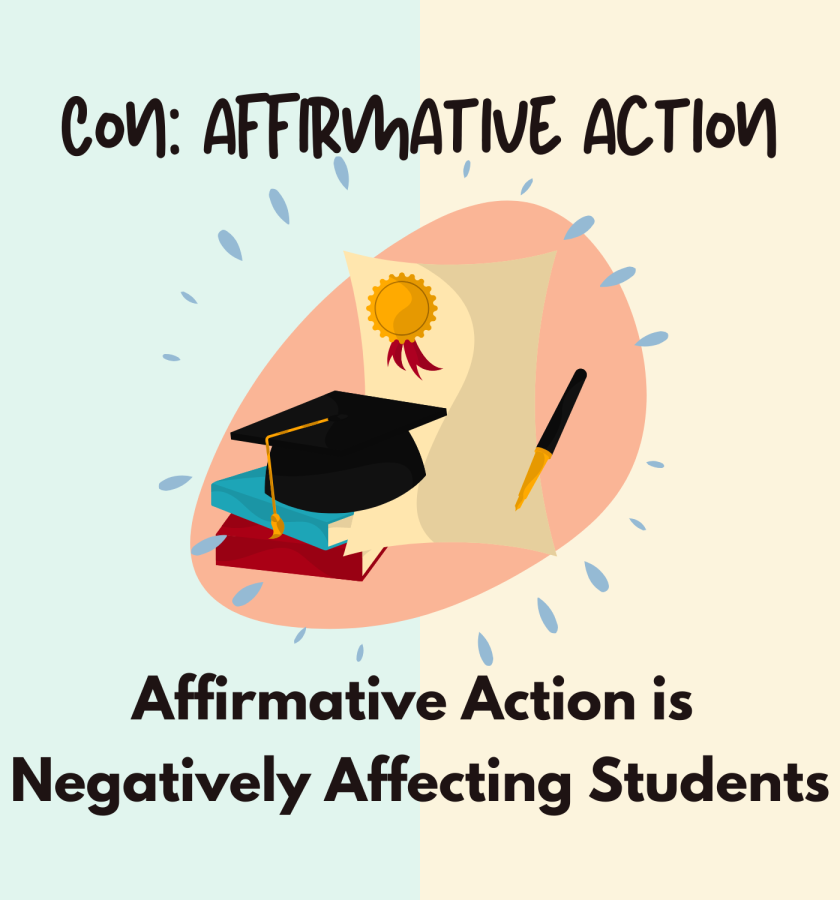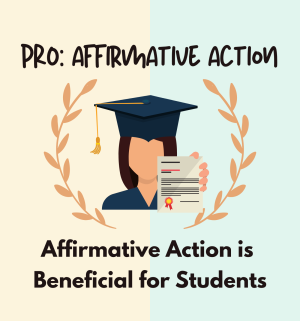Affirmative Action – con
Affirmative action is, in fact, harmful to students.
May 9, 2022
Affirmative action, which was started in the 1960s, aimed to make it so that people in education and employment would be treated without regard to race, gender, color, or religion. President Lyndon B. Johnson implemented affirmative action in employment, further expanding job opportunities for minorities. However, it has not fully served its purpose.
By lifting the ban on affirmative action, college and university admissions processes will become increasingly biased against certain minority groups such as Asians. Harvard University has kept its “quota” of Asians the same (16-19%), even though the population has doubled, coming under fire with many lawsuits against their admissions committee. Hence, with Affirmative Action, the system will begin to fulfill the quota-based admissions, rather than the academic-based admissions that it has been using as of now.
“I think that in the grand scheme of things, yes, it does help minorities, and people who don’t have many opportunities, but then … it discriminates against another race, specifically Asians,” said Y-Duyen Nguyen (‘23).
On top of specifically targeting certain minority groups, many groups feel that affirmative action is thinking less of minorities, and assuming that they are not able to perform as well as others.
Some African-Americans have challenged affirmative action because they feel that it is patronizing. They argue that the policies are racist, and are the assumption that African-Americans are unable to achieve educational and career success on their own without the assistance that affirmative action provides.
Though affirmative action is trying to help underrepresented groups to the foreground, they are discriminating against majority groups in hopes of a, sometimes, deluded equality.
In a journal, philosopher and ethics writer Louis P. Pojman writes, that “strong Affirmative Action is reverse discrimination. It says it is right to do wrong to correct a wrong.”
However, this systemic racism is not something that can be changed with just one “solution.” By adding affirmative action into college admissions and employment options, it discriminates against people who have worked their entire lives, in favor of filling a quota. Doing so does not help the population as a whole.
Though this deluded version of equality created by a quota-based system gets representation in workplaces, it doesn’t fulfill the original purpose, which is to create equality for everyone.
“It would be great if colleges wouldn’t be able to assume [based off of race], and [make] their decisions off of what is sent to them in the students’ application,” said Montana Parkinson-Lubold (‘24).
With consideration of neighborhoods with high crime rates, and consideration of communities without access to necessary resources and education as a whole, implementing a process of achieving equality would be required in every town, every community, and every state in the country.
By creating access to quality education around the country, in kindergarten and elementary school, it is possible to eliminate the idea of affirmative action in colleges and workplaces, and rather, open up the idea of naturalized equality.
“If you want to change the admission process, start with changing education when people are younger. Start with changing school district policies. Start with equality first,” said Katelyn Ma (‘23).





